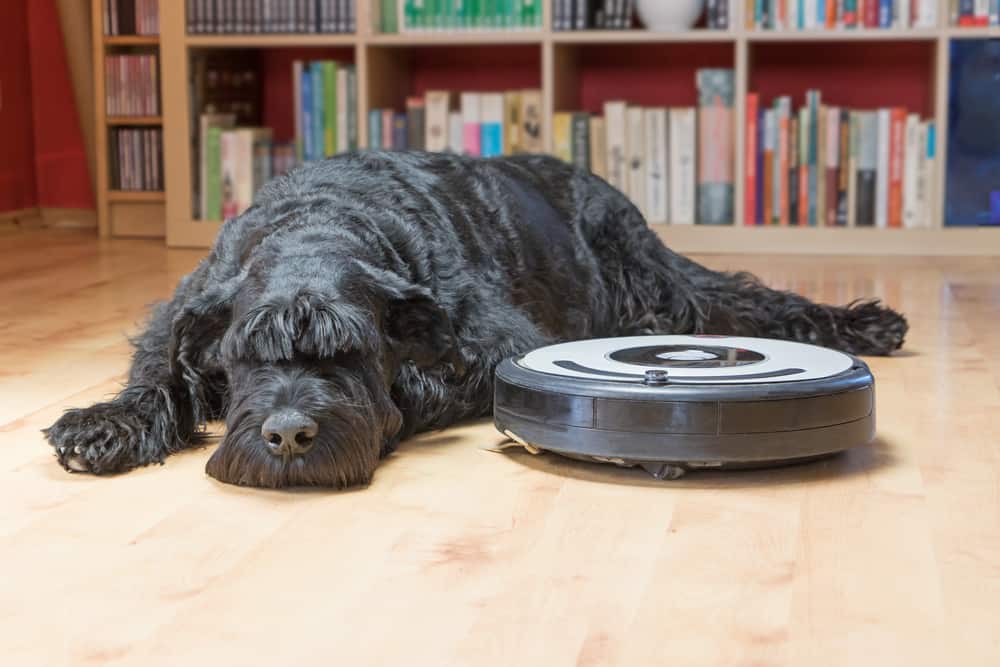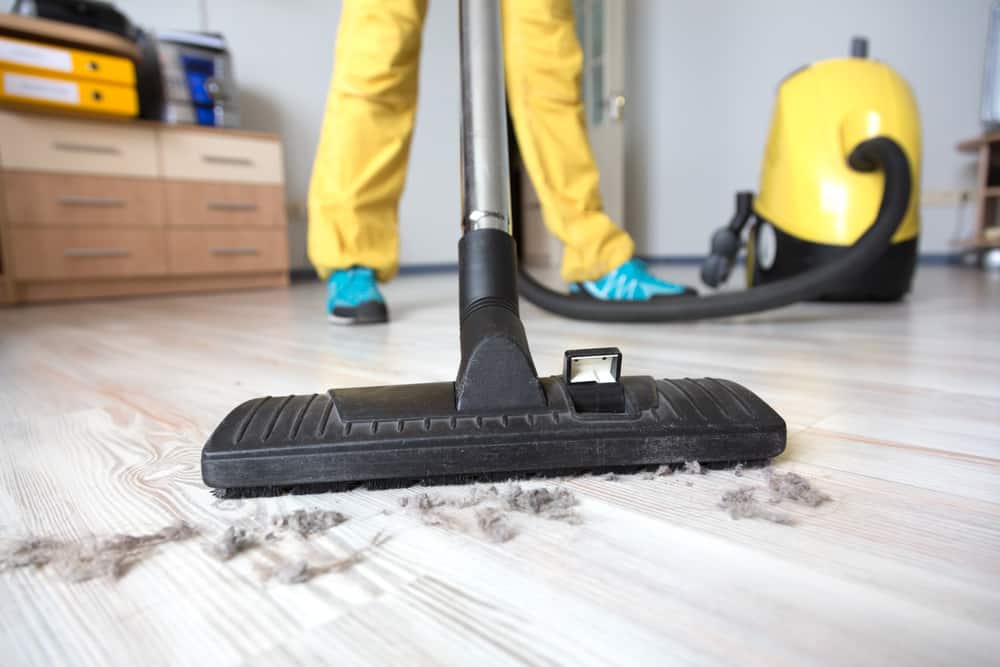We all love our pets, from rambunctious puppies to frisky cats. To us, they’re as much a part of our family as any other member.
But they do come with a unique set of challenges. One of which is finding the best pet vacuum cleaner to aid in the never-ending struggle against pet hair and shedding.
Do you look at your couch and wonder: Is my dog bald yet? Where does all this hair come from?! Well, rest assured, you’re not alone. Far from it.
But dog or other pet hair isn’t just visually appealing, it can also get ground into your furniture, curtains, carpet, and other fabrics, leading to your home smelling like a wet puppy or dog pound in no time flat. Not to mention excessive hair and dander build up can cause or aggravate allergies and make for a great breeding ground for mold and bacteria.
If you’re like most of us, your vacuum is your #1 weapon of choice…yet many fail to perform.
Are you tired of giving your current vacuum a pep talk every time you have to clean?
If you’re looking for a vacuum cleaner that’s easy to handle but tough on pet hair, keep reading for our top tips:
1. Consider the type of flooring in your home
Different types of flooring call for different considerations when seeking out an appropriate vacuum. For example, your cat or dogs hair will slide across your tile or hardwood flooring, but become tangled up and ground into your long bedroom carpet. Likewise, when your dog comes running inside after a rainy day, tracked in mud will simply dry up on the hardwood, but when it comes to carpeting or rugs, that dirt and grime will sink in deep.
Before you purchase a pet vacuum cleaner , think about the rooms that struggle with pet hair on a regular basis. What sort of flooring do you have near the back door? In the living room, where your cat or dog sleeps? In the kitchen, where the dog likes to beg for scraps?
Hardwood and tile surfaces
Hardwood and tile are generally simple surfaces to vacuum. However, a rotating brush on a stick vacuum can cause frustration: instead of sucking pet hair into your vacuum bag, you’ll spray the hair into all corners of your room. You’ll essentially make the mess worse. Fun is not a word you’ll use to describe this situation.
Most vacuums for pet hair have a “hardwood” or “brush-off” feature, but just in case, make sure your chosen model allows for manual on-off control of the vacuum brush.
For tile only flooring, a vacuum/steam-mop combination can help combat mud and dirt tracked in by pets. These vacuums will suction, steam, and wipe away dirt in a few simple motions, providing an efficient way to deep-clean tile floors and grout.
Carpet
To clean pet hair out of the carpet, simple suction often isn’t enough to get the job done right. Weak suction will leave you with the impression that your carpets are clean, handling surface level hairs with ease while leaving ground in hair and dander beneath the surface. Deep-rooted hairs and dander can cause odors, and create a breeding ground for bacteria and mold spores.
Both of which are triggers for allergies and asthma.
When seeking out a vacuum for carpet flooring, look for a strong rotating brush, which can pull debris and hair toward your vacuum. The brush will detangle pet hair from carpet and deep-clean your rooms.
In addition to looking for a pet vacuum cleaner with a strong brush, consider purchasing one with a steaming feature. Carpets tend to catch and retain more dirt and grime than hardwood or tile; they’re also notoriously difficult and time-consuming to clean thoroughly.
Stairs
Stairs, both hardwood and carpet, are a breed of their own. Most stairs can’t be easily vacuumed by stick and upright vacuums, and require either handheld versions or special attachments to your upright unit in order to get into the angles and crevices.
If you go for a handheld option, there are two important things to remember when selecting a vacuum for your pet hair: weight and battery life.
If your wrist begins to ache after a few minutes of vacuuming the stairs, you’ll be less likely to clean them on a regular basis. You could consider it your daily “wrist exercises,” or you could go the easier route and purchase a lighter pet vacuum.
Also, a handheld battery runs out much faster than a stick vacuum battery; some only last 15 minutes. Pet parents with plenty of stairs will probably prefer a corded hand vacuum cleaner to a battery-powered version.
Furniture
It’s no secret that furniture collects pet hair like a magnet, and some furniture is worse than others. For example, fabric couches tend to accumulate static electricity that literally pulls hair towards your sofa.

For furniture, look for a handheld vacuum with a narrow suction opening or an upright vacuum with nimble attachments. Ideally, unless your couch is leather, the attachments should have a soft brush attached as well. The narrow opening will ensure focused suction and clean in-between cushions, while the brush will detach hairs from textured fabric.
2. Research the types of vacuums for pet hair
When it comes to cleaning your home and floors, the right tool for the job makes all the difference in the world. And vacuum cleaners are no exception to the rule.
Below are a few tips you can use to find the best vacuum cleaner for dog hairs, cat hairs, and any other furry friends who shed in your house…
Determine your needs
Ask yourself: What’s my biggest pet struggle when it comes to pet hair in my home?
● Upright models are generally larger, better for covering significant space in a small amount of time (such as a family room covered in dog hair)
● Wet/dry vacuums can handle puddles and standing water, in addition to dirt and dry debris (say, if your puppy loves playing in the rain)
● Canister vacuums are lightweight options for homes with only tile and hardwood floors
● Stick vacuums are similar to brooms: though they don’t cover much space, they’re exceptionally lightweight
Vacuuming frequently is part of owning a pet, whether we like it or not. As such, we highly recommend stick and upright models for new pet owners due to their higher suction power and durability/lifespan under heavy use.
Stick models aren’t difficult to push, so they’ll be more enjoyable to use in a pinch. However, if you have a larger area to clean, an upright model will help you save time and generally do a better job.
Bag vs Bagless
Some vacuum cleaners collect hair and debris in a disposable bag, while others collect hair in a canister that can be emptied, cleaned, and returned to the vacuum for further use.
Which is better for pet hair?
While both types vacuum effectively, disposable bags are generally less preferable. With a canister, your vacuum will work well until the canister is completely full. With a bag, however, the efficiency of suction and cleaning power will decrease as the bag fills with pet hair.

It’s frustrating to run over a patch of hair multiple times to completely clean it. Canisters are also greener and wallet-friendly option, as they don’t need to be replaced.
3. Look for frequent-cleaning-friendly features
Finally, your vacuum should incorporate features that make it easy and fun to clean on a regular basis.
When you adopt a dog or a cat, you are bringing in a new family member that sheds year-round. For some breeds, springtime shedding is an event unlike none other, with fur canvasing every surface as your dog loses their winter coat. Other breeds might shed evenly throughout the year.
And if you think you’re off the hook with a thin-coated puppy, think again. While thin-coated breeds don’t tend to shed off globs of hair all at once, they shed consistently, and their hair tends to be thin and more rigid, sticking into fabric and carpet like you wouldn’t believe.
Below, we’ve listed some of the top features for vacuum cleaners for dog hair:
Lightweight Yet Powerful
If your vacuum cleaner is heavy and difficult to use, cleaning will feel like a burden. You won’t be interested in lugging the vacuum out of the closet, shoving it across the carpet, and emptying the bag if you’ve just come home after a long day at the office (unless you need to work some frustration out of your system, that is).
Lightweight models, on the other hand, probably weigh less than your pet – about 15 pounds or less. With a lightweight model, you can whisk the vacuum out of a corner, zip around your family room, and make cleaning up the stairs a breeze.
That said, lighter models may lack some of the power you need, so be sure to evaluate the suction strength and reviews prior to making your decision.
Cordless Options
Have you ever been three or four inches from the dirtiest corner of a room, only to hear the “wuuuh-wuuh-wuuuuh” of your vacuum power supply being cut off?
Cords provide limitless power, but limited vacuuming space. They can be tripped over, vacuumed up – even chased and chewed on by pets. A great alternative to corded vacuums are battery-powered models that you can simply sit on a charger overnight, and then clean your home cord-free in the morning.
Be sure to look for a model with good reviews. Batteries come in different levels of power, relative output, and lifespans.
Handheld/Stick Convertibility
Handheld vacuums for pet hair aren’t very helpful for floors, I mean who wants to get down on their hands and knees to vacuum?
But they can clear pet hair quite effectively from furniture, shelves, stairs, countertops, and other uneven or hard to reach surfaces. Some stick vacuums feature detachable handheld parts, usually featured at the top of the stick handle. These can allow for quicker and more thorough cleaning.
Corner And Under Bed Flexibility
We’ve all fought with an old clunky vacuum that won’t turn corners well or reach far enough under the bed. Vacuums that fail the mobility and flexibility test will leave you with corners and small areas where pet hair and dander will collect freely, while the rest of your floor looks clean as a whistle.
Although the no-turn vacuum is an outdated model, some modern pet vacuum cleaners still don’t feature agile performance and mobility features. Instead of just focusing on power when purchasing a pet vacuum, look for something with power and flexibility combined. There’s no point in cleaning up only half the hair.
Final Thoughts
If you’ve recently adopted a pet, you’ve gained a best friend for life. You’ll have their smiling face to come home to each day, their cuddles to cheer up, and their excitement over special treats and outings to brighten up your days.
But you’ll need to consider the additional home maintenance and responsibility that comes with pet ownership. And finding the right vacuum to clean your home is one of the first key steps to a healthy and cleanly living space for you and your family.
Sure, your fur baby might not like the sound the vacuum makes, but they’ll love the extra attention from a company you wouldn’t otherwise invite over due to a house smelling like a wet dog kennel.
The most important thing to remember is to find a vacuum that you like and that is easy to use as well as effective. If you love it, you’ll use it. And if you use it, and keep a clean house, you’ll open opportunities to enjoy your home and your pet’s company to the fullest.
